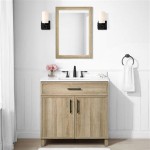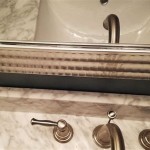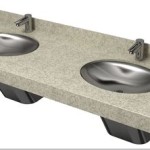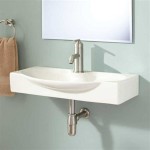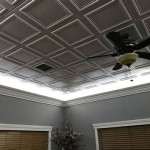How To Make An Old Bathroom Mirror Look New
Bathroom mirrors, subjected to constant humidity and splatters, often show their age before other fixtures. Stains, streaks, and even desilvering can detract from the overall appearance of the bathroom. While a complete replacement might seem like the only solution, several techniques and strategies can revitalize an old bathroom mirror, saving considerable expense and effort. The approaches range from simple cleaning methods to more involved repair processes, depending on the extent of the damage.
Before embarking on any restoration project, it's crucial to assess the condition of the mirror accurately. This assessment will determine the appropriate course of action and identify the necessary tools and materials. A visual inspection should focus on the presence of:
- Surface stains and streaks: These are typically caused by water spots, toothpaste splatters, or cleaning product residue.
- Fogging or haziness: This often results from the breakdown of the mirror's reflective backing.
- Desilvering: This manifests as dark spots or patches where the reflective silver layer has eroded.
- Edge damage: Chips or cracks along the mirror's edges can detract from its appearance and potentially pose a safety hazard.
- Frame condition: If the mirror has a frame, its condition should also be evaluated for damage, discoloration, or loose joints.
Based on the assessment, one can choose the appropriate method to rejuvenate the mirror. The simplest methods involve cleaning and polishing, while more severe damage may require desilvering repair or reframing.
Cleaning and Polishing for Surface Imperfections
The first step in revitalizing an old bathroom mirror is a thorough cleaning. This process removes surface stains, streaks, and grime that can accumulate over time. Before using any cleaning solutions, it's essential to dust the mirror with a soft, dry cloth to remove loose debris. This prevents scratching the surface during the cleaning process.
A variety of cleaning solutions can be used, each with its own advantages. A simple mixture of equal parts white vinegar and water is an effective and eco-friendly option for removing water spots and soap scum. The acidity of the vinegar helps to dissolve mineral deposits without damaging the mirror's surface. Another common solution is a commercial glass cleaner, readily available at most stores. These cleaners are formulated to remove grime and streaks without leaving residue.
When applying the cleaning solution, it's recommended to use a spray bottle. This allows for even distribution and prevents oversaturation, which can lead to streaks. Spray the solution onto the mirror surface, avoiding direct contact with the frame, especially if it's made of wood. Use a clean, lint-free microfiber cloth to wipe the mirror in a circular motion. For stubborn stains, allow the solution to dwell on the affected area for a few minutes before wiping. Avoid using paper towels, as they can leave lint behind.
After cleaning, polish the mirror with a dry microfiber cloth to remove any remaining streaks or residue. A polishing compound specifically designed for glass can further enhance the mirror's shine. Apply a small amount of the compound to a clean cloth and buff the mirror in a circular motion. Be sure to follow the manufacturer's instructions for application and removal. If the mirror has a frame, clean it separately with a suitable cleaner for its material (e.g., wood cleaner for a wooden frame, metal polish for a metal frame).
Regular cleaning is crucial for maintaining the appearance of a bathroom mirror. Wiping the mirror down after each shower can prevent water spots and soap scum from building up. This simple habit can significantly extend the time between more thorough cleaning sessions.
Repairing Desilvering for a Restored Appearance
Desilvering, the deterioration of the mirror's reflective backing, is a common problem in older bathroom mirrors. It manifests as dark spots or patches that detract from the mirror's appearance. Repairing desilvering is a more involved process than simple cleaning, but it can significantly improve the mirror's overall look.
Several methods can be used to repair desilvering, depending on the extent of the damage. For minor desilvering, a commercially available mirror repair kit can be an effective solution. These kits typically contain a silvering compound and a sealant to protect the repaired area. Before using the kit, thoroughly clean the affected area with alcohol to remove any dirt or grime. Follow the manufacturer's instructions carefully when applying the silvering compound. Typically, this involves applying a thin layer of the compound to the desilvered area and allowing it to dry completely. Once dry, apply a sealant to protect the newly silvered area from moisture and further deterioration.
For more extensive desilvering, a more comprehensive approach may be necessary. This involves removing the remaining silvering from the affected area and reapplying a new layer of reflective material. This can be done using a specialized silvering paint or a metal foil adhesive. The process requires careful preparation and precise application to achieve a smooth and even finish.
Regardless of the chosen method, it's crucial to protect the surrounding areas from damage during the repair process. Use painter's tape to mask off the areas adjacent to the desilvered spots. This prevents the silvering compound or paint from accidentally spreading to undamaged portions of the mirror. Work in a well-ventilated area and wear gloves to protect your hands from chemicals.
After the repair is complete, allow the repaired area to dry completely before handling the mirror. Once dry, inspect the repair carefully and touch up any imperfections as needed. A final coat of sealant can help to protect the repair and prolong its lifespan.
Reframing or Edge Treatment for a Fresh Aesthetic
The frame surrounding a bathroom mirror can significantly impact its overall appearance. An old or damaged frame can detract from the mirror's beauty, even if the mirror itself is in good condition. Reframing or applying edge treatments can provide a fresh aesthetic and enhance the mirror's visual appeal.
If the existing frame is damaged or outdated, consider replacing it with a new one. A wide variety of frames are available in different materials, styles, and finishes. Choose a frame that complements the bathroom's décor and reflects personal preferences. Before purchasing a new frame, measure the mirror accurately to ensure a proper fit. When attaching the new frame, use appropriate adhesives or fasteners to secure it firmly to the mirror.
If replacing the entire frame is not desired, consider refinishing or repainting the existing frame. This can be a cost-effective way to update the mirror's appearance without incurring the expense of a new frame. Before refinishing or repainting, thoroughly clean the frame and sand it down to remove any old paint or finish. Apply a primer to ensure proper adhesion of the new paint or finish. Choose a paint or finish that is suitable for the frame's material (e.g., wood paint for a wooden frame, metal paint for a metal frame). Apply the paint or finish in thin, even coats, allowing each coat to dry completely before applying the next.
For frameless mirrors, edge treatments can add a touch of elegance and sophistication. Beveled edges, polished edges, or decorative edge strips can enhance the mirror's visual appeal and create a more finished look. Beveled edges are created by grinding down the mirror's edge at an angle, creating a smooth and elegant transition. Polished edges are achieved by smoothing and polishing the raw edge of the mirror, resulting in a clean and refined look. Decorative edge strips, available in various materials and designs, can be applied to the mirror's edge to add a touch of personality and style.
When applying edge treatments, it's essential to use appropriate adhesives or fasteners to secure them firmly to the mirror. Follow the manufacturer's instructions carefully to ensure a proper and lasting bond. Work in a well-ventilated area and wear gloves to protect your hands from chemicals.
By carefully selecting and applying appropriate techniques, it's possible to breathe new life into an old bathroom mirror, transforming it from a dated eyesore into a stylish and functional focal point.

How To Frame A Bathroom Mirror For Just 10

How Do You Make An Old Bathroom Look New On A Budget

Diy Niche Shelf Old Bathroom Medicine Cabinet Makeover A Piece Of Rainbow

Simple Ways To Make A Framed Bathroom Mirror Hometalk

Bathroom Cabinet Mirror Ideas How To Make Your Space Look More Bigger And Better

Mirror Makeover For The Master Bathroom Beneath My Heart

Freshen Up Simple Ways To Modernize Your Old Bathroom The Mice Hirsch Group Real Estate Agent Studio City Sherman Oaks Valley Village Calabasas Encino Woodland Hills Los Angeles Realtor

Framing A Large Bathroom Mirror Maybe In The Kids If I Don T Replace

10 Spectacular Ideas For Backlit Bathroom Mirrors

Diy Niche Shelf Old Bathroom Medicine Cabinet Makeover A Piece Of Rainbow
Related Posts

